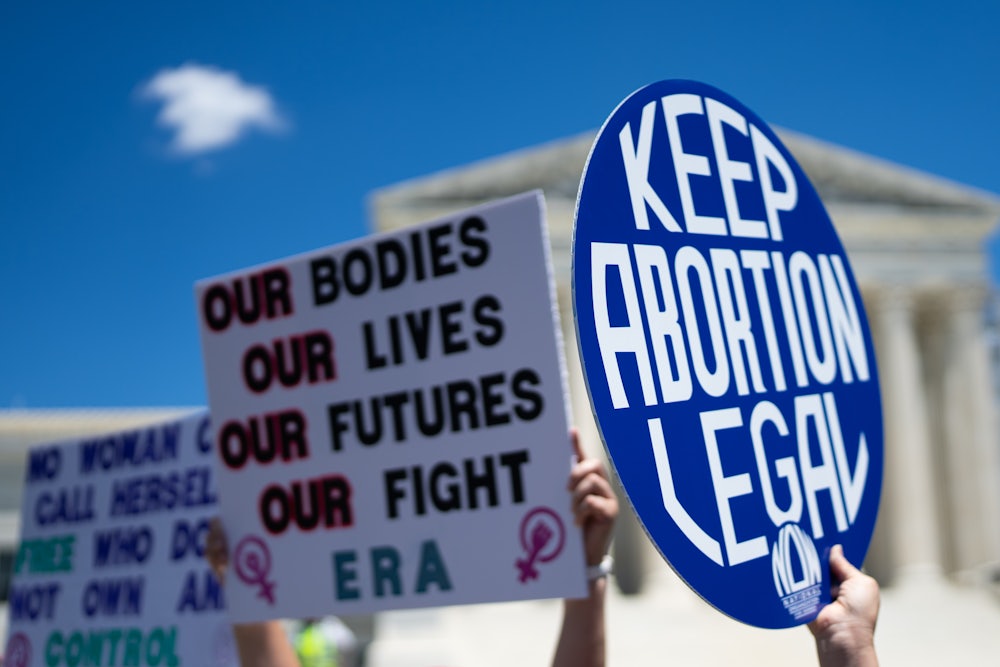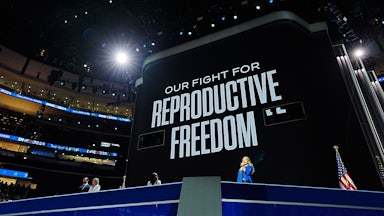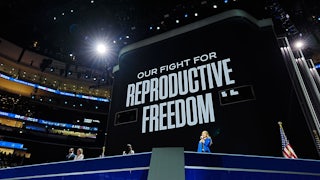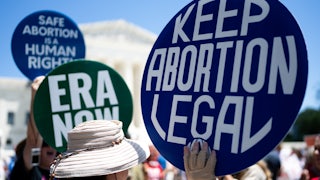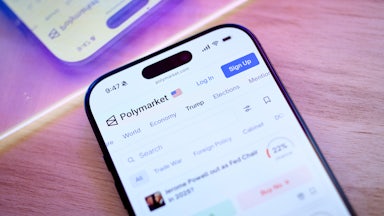Destini Spaeth’s organization needs money, but recently she’s been having ethical qualms about asking the same people for $20 to fund their neighbors’ abortions. As the care and advocacy coordinator of Prairie Abortion Fund, or PAF—which primarily serves abortion seekers from North Dakota, South Dakota, and Minnesota—she knows that many of the people who feel habitually compelled to donate to PAF are in a similar financial position to the people who need their help.
“While there’s really something beautiful about an entire community paying for one person’s abortion,” Spaeth said, “there are millionaires and billionaires who could write us a check and not blink.”
Spaeth knows the money is out there. She can see where it’s going with her own eyes. There’s the $600 million going to a pro-choice presidential candidate, $100 million for a 10-year federal campaign to overturn bans, another $40 million that went to an abortion ballot measure in a single state.
The organizations that raised the capital to fund these efforts are familiar; some of them have likely asked readers of this story for money via email, phone, or text. But abortion funds—the groups that help people afford their appointments and pay for any necessary travel, and did so long before the Supreme Court’s decision in Dobbs v. Jackson Women’s Health Organization made these matters much more complicated and expensive—don’t have that kind of infrastructure. Most are volunteer-led—or if they have staff, it’s not enough—and most days are spent putting out fires.
Spaeth, who has a full-time day job, said the fund can barely stay active on social media. “I don’t have the time to come up with some cute Canva design that’s going to entice somebody to donate,” she said. “I’m busy talking to callers and clinics and other abortion funds, navigating this hell that we’re in right now.”
The hell Spaeth is referring to is the struggle that abortion funds like her organization face since Dobbs was handed down. As the post-Dobbs rage donations have petered out, it’s gotten much harder to raise enough money to help every abortion seeker in need. These hardships were made exponentially worse in July after the National Abortion Federation and Planned Parenthood made cuts to patient grants, a decision that has sent funds scrambling. These groups need more money, or more people will be forced to give birth, but at the moment, huge amounts of both money and attention are being diverted toward abortion ballot measures and pro-choice political campaigns promising abortion access later, when people need care now.
It’s in this environment that a small group of funds is trying a different way to expand their capacity, and hopefully their budgets. PAF is one of three abortion funds—alongside Arkansas Abortion Support Network and the Wild West Access Fund—getting strategic support and financial assistance from the Frontline Repro Freedom Lab, or FRFL, a new incubator backed by women with decades of experience in state-level advocacy. The founders met while working on gun violence prevention laws with frontline organizations.
FRFL is assisting the inaugural cohort with organization building—things like running digital ads to build their supporter base, creating templates for emails and social media posts, donor database management, and recruiting and training volunteers. It’s basic infrastructure support that the funds say their umbrella organization, the National Network of Abortion Funds, or NNAF, doesn’t currently provide. The lab is supported by a grant from the JM Kaplan Fund, which is known for investing in early-stage projects, and has provided a sub grant for each fund to spend how it sees fit. It’s slated to run through early 2025.
Valerie Jean-Charles, a lab co-founder and its communications and media adviser, said the pilot is “a direct response” to a resource crisis about which her reproductive rights colleagues have been sounding the alarm. Lab co-founder Sarah Jane Higginbotham said what they’re doing isn’t exactly rocket science: “We’re just listening, and they’re telling us they have no money.”
Higginbotham says that helping funds run ads, build their email lists, and get more small-dollar recurring donors is about creating “just a bit of damn breathing room in the short to medium term.” A dose of much-needed relief could help funds close gaps following the cuts at the national level, but they have a longer-term goal as well: to drive attention to the work of abortion funds so that larger philanthropic institutions expand how they think about their giving, and hopefully resource them more directly.
According to the National Committee for Responsive Philanthropy, foundation funding only accounts for 37 percent of abortion funds’ budgets, while 63 percent comes from individual donors. “We really don’t believe in a scarcity mindset,” Higginbotham said. “We think there’s plenty of resources to support abortion access.” She envisions hosting a readout once the lab is over, where fund leaders share what they’re learning with larger-scale funders.
Macy Haverda, executive director of the Wild West Access Fund of Nevada, said WWAF was assisting 75 to 85 people a month before the July funding cuts disrupted the already precarious ecosystem. Now they’re funding at least 150 abortion seekers every month. Karen Musick, acting director of the Arkansas Abortion Support Network, said that as of early September, the fund had already spent more on patient assistance than it did in all of 2023.
The paid staff and volunteers for AASN are extremely passionate about their work, which includes procedure and travel funding and running a pregnancy resource center that counsels people on all their options and provides free emergency contraception, condoms, and pregnancy tests. But Musick said, “We’re not natural fundraisers.” So when the lab reached out, she was interested immediately. “It filled a gap that we didn’t have, which is trying to be more effective at raising money,” she said. Musick said NNAF has been “hugely supportive” from a legal standpoint, “but the money is pretty much our responsibility.”
Haverda said she has worked for nonprofits before, but “this is the first thing I’ve ever done in my life where, when we get money, we just give it right back out.” Low overhead isn’t itself a bad thing, but Haverda said funds don’t have the resources to “really prioritize building out comms structures and building out media campaigns.” (Alternatively, when people donate to local funds, they know exactly where their money is going; the same can’t be said for national organizations.) Haverda hopes the lab will help shine a light on individual funds and help them build a broader base of support.
Abortion funds were born out of Roe’s failure to guarantee access. Spaeth and Musick both said their long-term vision is that organizations like theirs no longer exist because abortion is legal in every state, no matter at what stage of pregnancy people need the procedure, and is covered by public and private insurance. But funds are increasingly skeptical that the current reproductive rights movement is best equipped to advocate for changes in abortion access given that they are working to rebuild a legal framework that left so many people behind. Two of the three funds in the lab cohort signed an open letter in The Nation calling out Planned Parenthood and others who they said “fundraise endlessly, siphon support from institutional funders and grassroots donors,” in what they call “a gross abuse of funding and publicity that deprioritizes actual access to abortion care right now.”
Haverda also noted that the strategies of these national organizations don’t always work for abortion seekers. One example that she was quick to point to was the ongoing effort to repeal the Hyde Amendment, an annual budget rider dating back to 1976 that bans federal funds from paying for abortions via programs like Medicaid and the Indian Health Service. President Joe Biden became the first president to support ending Hyde, but he didn’t didn’t have full control of Congress to do it.
Haverda argued that if a fraction of the money spent on long-running anti-Hyde campaigns had gone toward abortion funds, most if not all of the care that low-income abortion seekers require could have been paid for. “The amount of money that’s gone into trying to repeal the Hyde Amendment could have really just done the work of repealing the Hyde Amendment,” she said. “Instead we’ve been funding all of these huge salaries over these last 20 years of people at these big organizations.”
Don’t get her wrong; Haverda wants Hyde repealed, but she added, “You’re not really helping people by continuing to pump money into the same beast over and over and over again.”
Speaking of money-guzzling beasts: Nevada has an abortion amendment on the ballot this November that would codify Roe, and it and other political fights are sucking up all the oxygen. “Especially in an election year,” Haverda said, “the only thing anybody really wants to fund right now is what they call movement building and coalition building”—as opposed to direct service work like abortion funds. And in Nevada, amendments have to pass twice, so it will be on the ballot again in 2026.
No matter who wins in November, building funds’ capacity will be crucial, and it’s a key goal of the lab. A potential President Kamala Harris can’t snap her fingers and overturn abortion bans; she’ll need majorities in the House and Senate to pull that off—an unlikely scenario given that Democrats are forecast to lose the Senate. But a Harris win could result in donors both big and small coming to believe that the battle is won and that abortion organizers no longer need their money. Jean-Charles has lived through this scenario after previous elections: “Folks who used to care about your issues go away because they assume that, ‘well, this person is going to take care of it.’”
Pro-choice people might falsely think things are “fixed” when they see positive news developments under a Democratic president, like when a North Dakota lower court judge recently struck down the state’s abortion ban. But the state is appealing the ruling, and, crucially, there are no abortion clinics left in North Dakota. PAF updated its Instagram followers to remind them that just because something is legal does not mean it’s accessible.
Even more pointedly, Spaeth said Democrats remaining in the White House merely prevents new federal restrictions. “A Harris presidency does fuck all for red states” she said. “It would be years and years and years to be able to undo the damage that’s been done.” Meanwhile, conservative-led states will continue trying to crack down on abortion travel and assistance, via what she called “aiding and abetting bullshit.”
Despite the looming threats, Musick is excited at the prospect of growing AASN during and after the lab. It’s a good time, as Arkansans are pissed that they won’t have the chance to vote on abortion this fall. (Organizers collected more than 100,000 signatures, but the state rejected the ballot over paperwork for paid canvassers, and the Arkansas Supreme Court upheld the decision.)
But in advocates’ minds, even getting that many signatures was something of a moral victory. “There’s a power that all of us felt. That all of a sudden, things have changed,” she said. “I believe that people have become awakened in Arkansas.”
Musick said AASN has a postelection fundraiser planned that they’re calling a smash-a-thon, where people who donate can use a bat to take out their rage on an old car. “We might get 2,000 bucks from it,” she said, an amount that pales in comparison to the $35,000 they spent each month in 2023. “I don’t care what it is, because we’ve got to keep working. We have to keep trying and just doing all we can.”
